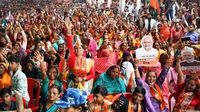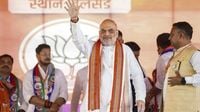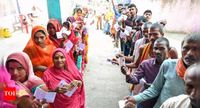As the 2025 Bihar Assembly elections gather momentum, the state has found itself at the epicenter of India’s political conversation, not just for the fiery rhetoric on the campaign trail but also for a historic surge in voter participation. On November 6, 2025, Bihar set a new benchmark: the first phase of polling, spanning 121 constituencies across 18 districts, saw voter turnout reach an unprecedented 65 percent. According to India Today, this figure surpasses the previous high of 62.5 percent recorded in the 2000 elections, marking an 8.6 percentage point jump compared to the same seats in the 2020 Assembly polls.
This remarkable uptick has left political analysts, party strategists, and citizens alike pondering its implications. Does a record turnout signal an appetite for change, or does it reinforce the strength of the incumbent? The answer, as it turns out, is far from straightforward.
Prime Minister Narendra Modi, addressing a rally in Aurangabad on November 7, seized the moment to sharpen his attack on the Opposition. He accused Congress leaders of side-stepping a discussion on the Rashtriya Janata Dal’s (RJD) manifesto, calling it “a bunch of lies.” According to India Today, Modi charged that the Opposition was “misleading voters in Bihar with false promises” as the campaign intensified ahead of the second phase of polling, scheduled for November 11, 2025. The Prime Minister’s remarks reflected the charged atmosphere as parties vie for every vote in a state that has long been a bellwether for national politics.
Meanwhile, the presence of other prominent political figures underscored the high stakes. Uttar Pradesh Deputy Chief Minister Brajesh Pathak was active on the ground, lending support to allied campaigns, while Janshakti Janata Dal President Tej Pratap Yadav was spotted at Patna Airport meeting BJP leader Ravi Kishan, a moment that drew attention in political circles. The Election Commission of India, for its part, has been lauded for its voter awareness campaigns, which many credit for the surge in participation.
But what does this historic turnout really mean? To answer that, it’s worth looking beyond Bihar’s borders. A comparative analysis of turnout patterns across five major Hindi-speaking states—Bihar, Uttar Pradesh, Madhya Pradesh, Rajasthan, and Haryana—offers some clues, though not always definitive ones. Historically, Bihar’s voter participation hovered in the modest 42–44 percent range in its first three elections. The first major spike came in 1967, when turnout crossed 51 percent, ushering in Bihar’s first non-Congress government. Subsequent surges in 1980 and 1990 also coincided with regime changes, reinforcing the notion that high turnout could signal political upheaval.
Yet, this pattern has not always held. The 2000 election, for instance, saw turnout soar to 62.5 percent, but the incumbent managed to retain power. In a twist, the following 2005 election brought a regime change despite a dramatic 17-point drop in voter participation. These contradictions have made it difficult to draw a straight line between turnout and electoral outcomes in Bihar.
Neighboring Uttar Pradesh presents a similarly mixed picture. According to India Today, sharp increases in turnout have sometimes coincided with the emergence of a new ruling party or coalition. However, in 2007, a significant drop in turnout also resulted in a change of guard. More recently, a record-high turnout in 2022 saw the incumbent hold onto power. Madhya Pradesh’s recent history echoes this ambiguity: while earlier decades saw turnout surges heralding change, since 2003, rising participation has mostly resulted in the continuation of the ruling party. The 2023 polls there, which recorded a record 77 percent turnout, delivered a resounding victory for the incumbent.
Rajasthan’s story is one of tradition: the state has alternated governments every five years, with turnout remaining near record highs since 2013. Haryana, long known for its robust voter engagement, registered its highest-ever participation rate of 76 percent in 2014—a year that did see a regime change. Yet, subsequent elections with lower turnout saw the incumbent cling to power.
What emerges from this regional comparison is a nuanced reality: while higher voter participation is often interpreted as a sign of political ferment, it does not guarantee change. In many recent elections, incumbents have weathered turnout surges, suggesting that other factors—such as candidate appeal, campaign strategies, and local issues—play decisive roles.
In Bihar, the current surge is partly attributed to the Election Commission’s extensive voter awareness drives. These initiatives, which include grassroots outreach, social media campaigns, and logistical improvements, have made it easier and more compelling for citizens to cast their ballots. The result is a more engaged electorate, but one whose intentions remain difficult to predict.
Against this backdrop, the rhetoric on the campaign trail has grown sharper. Prime Minister Modi’s pointed critique of the RJD’s manifesto and his charge that the Opposition is “misleading voters” reflect a broader strategy to frame the election as a battle between trust and deception. The Congress and its allies, for their part, have sought to turn the spotlight on issues of governance, unemployment, and development, arguing that a change is necessary to address Bihar’s longstanding challenges.
Political observers have noted that the high turnout could be a double-edged sword. On one hand, it may indicate a groundswell of support for change, especially among younger and first-time voters. On the other, it could reflect effective mobilization by the incumbent’s machinery, ensuring that their base turns out in force. The historical record, as India Today points out, offers examples of both outcomes.
As the second phase of polling approaches, all eyes are on Bihar. Will the unprecedented turnout translate into a new political order, or will it reinforce the status quo? The answer, as history suggests, will only become clear once the ballots are counted. Until then, the state’s voters—energized, engaged, and more numerous than ever—remain the true protagonists of this unfolding democratic drama.
For now, the only certainty is that Bihar’s 2025 Assembly elections have already made history, both at the ballot box and in the hearts and minds of its people.


